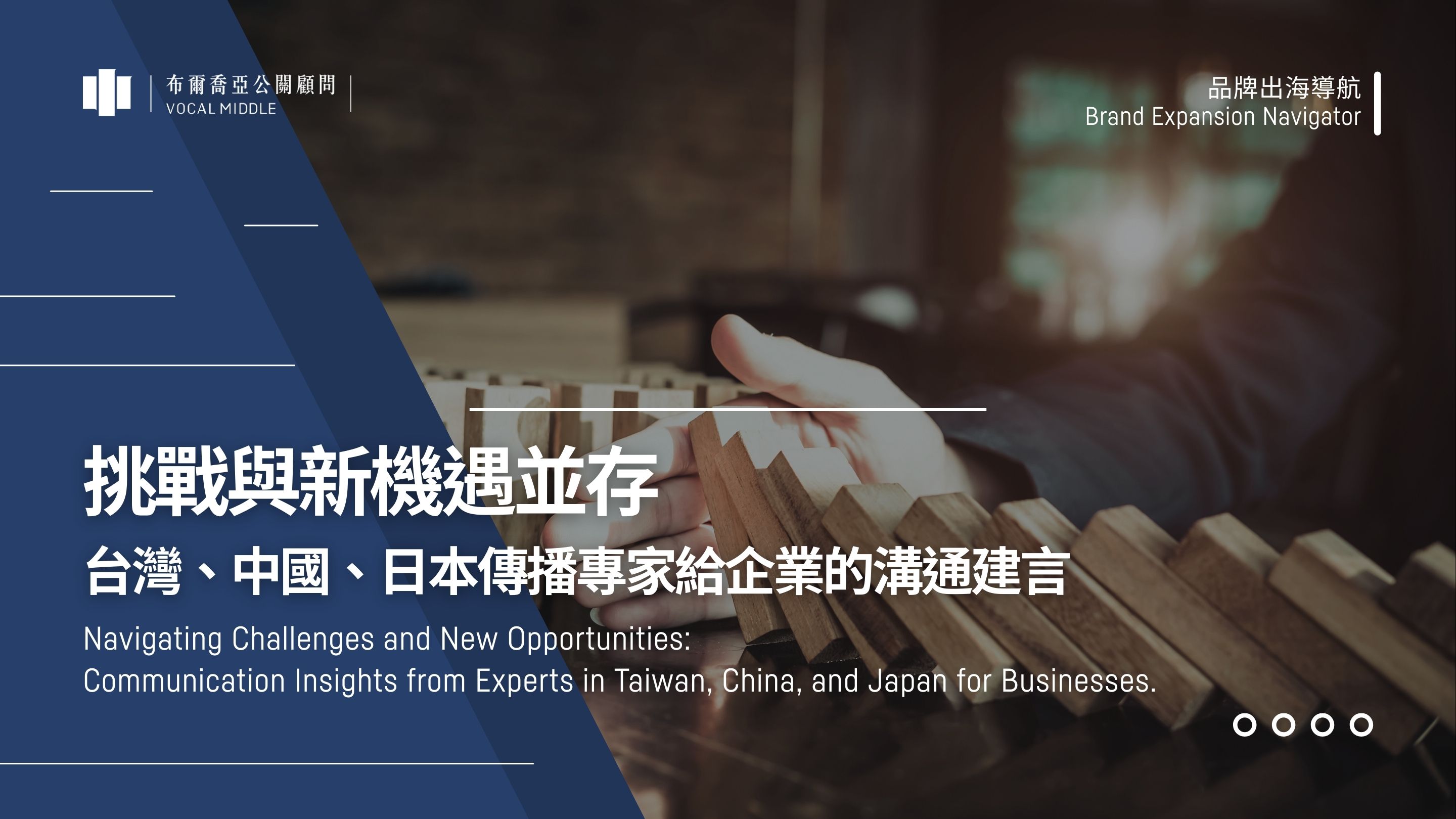
品牌出海導航主持人暨台灣傳播專家代表/資深公關顧問總監 周婷筠(Sheila Chow)
議題設計、編輯/資深項目管理師 江美吟(Mia Chiang)
(以下內容為繁體中譯版,原始英文版請往下滑)
川普關稅政策引爆全球動盪,雖然在動盪近兩週時間後,有漸緩的趨勢,但全球企業已然重新評估自身的機會與挑戰,並啟動各種應對策略及行動。同時也延伸至企業如何進行溝通、重新定位自身角色,並保護其全球布局。
在這波不確定性重現的情勢下,布爾喬亞已迅速彙整訊息、盤點機會與風險後,隨之執行廣度與深度並行的多向溝通,理解企業客戶的需求,並提出「區域聚焦+在地深耕+靈活應變」的三重策略整合解方。(推薦參考:【首席布爾喬亞專欄】動盪新秩序,溝通新戰略(New Order, New Communication Strategies))
本次我們邀請來自台灣、中國大陸與日本的資深傳播領袖,請他們分享當地企業是如何應對,以及策略性溝通可在此時發揮的關鍵作用。
在台灣,從政府至私營企業(尤其半導體和電子產品領域)均提出針對性的相應行動,包含:
而公關顧問作為企業與市場及利益關係人溝通的引路人,正是企業應對由政策驅動的不確定性時,提供戰略傳播的關鍵角色。以台灣企業的現況來說,我會給三個建議:
關稅起初可能只是政策,但卻造成企業需要調整決策、裁員、預算削減以及商業不確定性。全球供應鏈的關係錯綜複雜,儘管中國近年來對美國貿易的依賴有所下降(來自美國的進口現在僅佔總進口的6.3%),仍是無法使這些變化孤立存在。
我們的一位零售客戶最近對消費者情緒和他們的收入目標表達了嚴重擔憂。中國微軟的本地服務部門已宣布立即關閉。關稅對不止對一個國家造成傷害,更是對全球定價、消費者成本和多邊經濟關係的穩定性施加壓力。
中國企業主要以以下三種方式回應:
從溝通的角度來看,我建議:
面對川普關稅政策的施壓,日本企業並不孤單。他們正在與來自南韓、德國、以及日益增長的東南亞和墨西哥的全球競爭者競爭,這些企業可能在美國市場上提供更低的成本或更強大的影響力。在這種情況下,日本企業面臨著不僅要維持競爭力,還要顯示出與美國經濟利益明確對齊的壓力。
例如,豐田作為日本最具標誌性的全球品牌之一,最近對其美國車型推出了顯著的價格優惠。這一舉措反映了豐田試圖在不確定經濟中刺激消費者需求,以及對美國市場反應的信號。與此同時,軟銀集團執行長孫正義 則採取了更直接的方式——親自與川普會面,承諾對美國科技產業和基礎設施進行大規模投資。這些行動顯示出,許多重要的日本企業正在積極努力重建與美國政府的關係,嘗試緩解貿易談判並維持穩健的經營環境。
事實上,這並非日本企業首次面臨此類挑戰。早在 1980 年代,日本與美國之間便歷經過激烈的貿易摩擦,特別是在汽車與電子產業。當時,日本不僅面對高額關稅,也遭遇日圓急遽升值,導致出口商品成本增加、競爭力下滑。為了應對這些困境,眾多日本企業選擇直接在美國投資,如設立製造工廠、聘用當地員工,並與美國企業成立合資公司。
這樣的策略性轉型,不僅成功避開了貿易限制,也有效降低政治摩擦,更重要的是,它幫助日本企業從單純的「外來供應商」,轉型為「美國經濟的在地參與者」。這段歷史經驗,在今日面對保護主義政策再現之時,尤具參考價值。 同時也呼應了過往的成功案例,如三菱與Chrysler的合作,或森永「Hi-Chew」成功打入美國市場的策略。
我給企業的兩個關鍵傳播建議:
不只是翻譯,更要建立真正的在地連結:企業訊息應反映美國受眾的價值觀與生活方式。不能僅僅翻譯日文宣傳內容,而是要重新思考品牌如何以自然、易產生共鳴的方式講述自身故事,真正融入當地文化語境。
強調在地貢獻與共創價值:企業在美國的溝通策略應明確展現其對當地社會的正面影響。不論是創造就業機會、推動創新,或參與社區公益,這些行動都是建立信任與好感的重要元素。
當今的貿易環境下,傳播早已不再只是支援性功能,而是一項關鍵的策略槓桿,能有效協助企業降低風險、凸顯市場差異化,並為未來做好準備。
延伸推薦:
(International English Version)
Trump's tariff policies have triggered global turmoil. Although there has been a trend of easing after nearly two weeks of upheaval, global companies have already reassessed their opportunities and challenges and initiated various response strategies and actions. This also extends to how companies communicate, reposition their roles, and protect their global layouts.
In the face of this resurgence of uncertainty, VOCAL MIDDLE has quickly consolidated information, assessed opportunities and risks, and executed multi-directional communication that balances breadth and depth, understanding the needs of corporate clients, and proposing a threefold strategic integration solution of "regional focus + local deep cultivation + flexible response." (Recommended reference: 【CEO Talks】New Order, New Communication Strategies.)
In this Topic, we invite senior communication leaders from Taiwan, mainland China, and Japan to share how local companies are responding and the key role that strategic communication can show the influence at this time.
The Trump tariff proposal, though targeted at China, had wide-reaching effects across Asia. For many Taiwanese businesses, particularly in semiconductors and electronics, the disruption created both challenges and new openings. It also highlighted the critical role of strategic communication in navigating policy-driven uncertainty.
In response to the tariffs, Taiwan’s government and private sector moved swiftly:
Three Key Communications Priorities
The effects are already rippling through. One of our clients in retail recently shared serious concerns over the consumer sentiment and their revenue target. Microsoft China’s local services branch was announced to close, immediately effective.
Tariffs may start as policy, but their impact shows up in real decisions, layoffs, budget cuts, and uncertainty within business. And while China’s reliance on U.S. trade has declined in recent years—with imports from the U.S. now making up just 6.3% of total imports—the global supply chain is far too interconnected for these changes to remain isolated.
In short, tariffs hurt more than one country. They put pressure on global pricing, consumer costs, and the stability of multilateral economic relations.
We’ve seen businesses respond in three major ways:
From a communications standpoint, I’d suggest:
Japanese companies are not alone in facing the pressures brought on by the Trump Tax Proposal. They are competing with global players—including firms from South Korea, Germany, and increasingly from Southeast Asia and Mexico—who may offer lower costs or stronger local footprints in the U.S. market. In this landscape, Japanese firms are under pressure to not only maintain competitiveness but also show clear alignment with U.S. economic interests.
For example, Toyota, one of Japan’s most iconic global brands, recently introduced significant pricing incentives on its U.S. models. This move reflects both an effort to stimulate consumer demand in an uncertain economy and a signal of responsiveness to the American market. At the same time, SoftBank CEO Masayoshi Son has taken a more direct approach, meeting personally with Donald Trump to pledge large-scale investments in the U.S. tech sector and infrastructure. These actions show that major Japanese companies are working proactively to rebuild ties with the American administration, aiming to ease trade negotiations and maintain a strong operating environment.
This is not the first time Japanese businesses have faced such challenges. Back in the 1980s, Japan and the U.S. experienced intense trade friction, particularly in the automotive and electronics sectors. At that time, Japan faced both high tariffs and a sharp appreciation of the Japanese yen, which made exports more expensive and less competitive. In response, many Japanese corporations began investing directly in the United States—building manufacturing plants, hiring American workers, and forming joint ventures with U.S. firms.
This strategic shift helped Japanese companies sidestep trade restrictions and reduce political friction. More importantly, it allowed them to establish themselves as local contributors to the U.S. economy rather than foreign exporters. That history is an important lesson today, as companies once again navigate a protectionist policy environment.
This includes investing in U.S.-based production facilities, hiring local talent, and building partnerships with American companies. These steps help present the brand not just as a foreign supplier, but as a contributor to the local economy. The approach mirrors earlier success stories, such as Mitsubishi’s collaboration with Chrysler or the market penetration strategy of Morinaga’s Hi-Chew.
Key Communication Recommendations for Businesses
Go Beyond Translation and Build Genuine Local Relevance:
Messages should be crafted to reflect the values and lifestyles of the American audience. Instead of simply translating Japanese messaging, businesses should rethink how they tell their story in a way that feels natural and relatable to the U.S. market.
Emphasize Local Contribution and Shared Value
Communication should clearly highlight how the company benefits American society. Whether it’s through job creation, innovation, or community support, these contributions can play an important role in building trust and goodwill.
In today’s trade environment, communications is no longer a support function, it is a strategic lever for de-risking, market differentiation, and future-proofing.
2025 公關策略開箱會|年終旗艦場:12/10(三)新時代的職涯真相── 心理韌性 x 領導特質 x 國際級標準